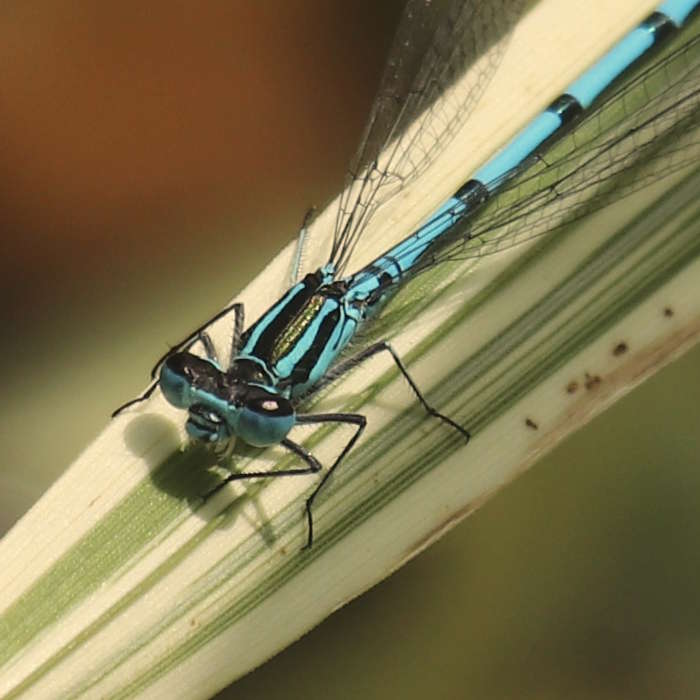Devon Wildlife Trust The Azure damselfly is a small blue damselfly that is very common around most waterbodies and can also be found away from breeding sites in grassland and woodland. It is on the wing from the end of May through to September. Damselflies do not fly as strongly as dragonflies, so tend to lay in wait for their insect prey before catching it in mid-air with their legs. They will return to their perch to eat their prey.
How to identify
The Azure damselfly is pale blue with bands of black along the body. To identify the small blue damselflies, of which there are seven species in the UK, it helps to concentrate on the pattern on the second segment of the males' abdomen, just behind the thorax. In the Azure damselfly, this segment is blue with a black U-shape.
https://www.devonwildlifetrust.org/wildlife-explorer/invertebrates/damselflies/azure-damselfly
British Dragonfly Society Common and widespread Damselfly species. Male: blue and black; ‘U’ shaped marking below the base of the wings. Female: green and black.
https://british-dragonflies.org.uk/species/azure-damselfly/

Male Azure Damselfly in our garden pond, Chulmleigh, photo by Grant Sherman 20th June 2020
Devonshire Association Entomology Section The Entomology Section promotes the study and recording of insects and also spiders in the county.
Meetings, talks, exhibitions, publications and field trips are arranged annually across the county of Devon and are suitable for beginners and experienced alike. Field trips are usually held in association with other specialist groups with whom we maintain close links. We also meet with other sections to demonstrate, and learn, about the inter-relationships with other disciplines.
With at least ten specialists in different Orders within the insect class we cater for a wide range of interests. Some of our Recorders are national experts in their field and hence we are the major collective source of entomological expertise in the county.
https://devonassoc.org.uk/organisation/sections/entomology-section/
Devon Biodiversity Record Centre Submit your sightings of Azure Damselflies and other species in Devon
https://www.dbrc.org.uk/wildlife-sightings/
British Naturalist's Association Dragonflies and damselflies are both members of the order Odonata. Thre have been 57 species recorded in Britain, made up of 17 damselflies (suborder Zygoptera) and 25 dragonflies (suborder Anisoptera). Of these, 42 species (17 damselflies and 25 dragonflies) are resident breeders, and the remainder are either now extinct species, or vagrants. In addition two species, Southern Skimmer Orthetrum brunneum and Southern Darter Sympetrum meridionale have been recorded in the Channel Islands.
https://bna-naturalists.org/id-guide-dragon-and-damselflies/
Buglife is the only organisation in Europe devoted to the conservation of all invertebrates. We’re actively working to save Britain’s rarest little animals, everything from bees to beetles, worms to woodlice and jumping spiders to jellyfish.
National Biodiveristy Network The NBN Atlas is a collaborative project that aggregates biodiversity data from multiple sources and makes it available and usable online. It is the UK’s largest collection of freely available biodiversity data.
https://species.nbnatlas.org/species/NBNSYS0000005606
Wikipedia The azure damselfly (Coenagrion puella) is a species of damselfly found in most of Europe. It is notable for its distinctive black and blue colouring. They are commonly found around ponds and lakesides during the summer.







